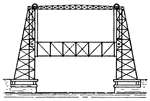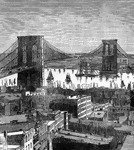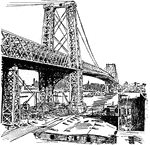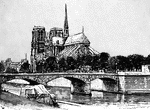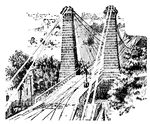New East River Bridge, NY
The New East River Bridge is located in New York. It is often called the Brooklyn Bridge. It is the…
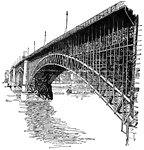
Eads Bridge
A steel arch bridge erected in 1874 and costed around one million dollars. Crosses over the Mississippi…

East River Bridge
The suspension-bridge over the strait called the East river, which seperates New York and Brooklyn was…

Shenandoah Valley
"The army of General Fremont on its march up the Shenandoah Valley- wounded and ragged soldiers. Fremont…

Old Church
"Desperate skirmish at Old Church, near Tunstall's Station, VA., between a squadron of the Fifth United…

Munson's Hill
"Skirmishing between the pickets of the two armies near Munson's Hill- the hill in the distance. Munson's…

Pontoon bridge
"General Fremont's Division crossing the Pontoon Bridge over the Shenandoah River in pursuit of the…

Battle at Potomac
"Engagement between the Federal troops and the Confederates on the Virginia side of the Potomac, opposite…

Engagement at Romney
"Engagement at Romney, VA., twenty miles from New Creek, Tuesday, June 11th, 1861- the Eleventh Indiana…

Crossing of Shenandoah River
"Colonel Pilson's Battery shelling the rear guard of the Confederate General Jackson's Army, at the…

Howard's Bridge and Mill
"Advance of the Federal troops, near Howard's Bridge and Mill, four miles from Big Bethel, on the road…

Battle at Willis Church
"Battle at Willis Church, Monday, June 30th, 1862- the Federal forces, under General Heintzelman, engaged…

Bouquet Battery
"The Bouquet Battery, commanding the viaduct over the Patapsco River, on the Baltimore and Ohio Railroad,…

Rappahannock Bridge
"Rebuilding of the railroad bridge over the Rappahannock to Fredericksburg, burnt by the Confederates…

Edward's Ferry
"Successful retreat of the Federal troops from the Virginia shore across a canal-boat bridge at Edward's…

Strasburg Woods
"In the Shenandoah Valley- General Fremont's division marching through the woods to attack the Confederates.…

Fort Thompson
"View of New Berne, N. C., from the interior of Fort Thompson after its capture by the Federal forces-…

Creek Railroad Bridge
"Burning of the gunpowder Creek Railroad Bridge, on the Philadelphia and Baltimore Railroad, by the…

Battle of Savages Station
"Battle of Savages Station. Brigadier General Smith's division hotly engaged with the enemy, at noon,…

Kentucky Raid
"The Confederate raid into Kentucky- the fight at the Licking Bridge, Cynthiana, between the Federal…

Kentucky Raid Rally
"The Confederate raid into Kentucky--excitement at Convington--gathering of armed Federal citizens at…

Battle of Malvern Hill
"Battle of Malvern Hill, near Turkey Bend, James River, Va., fought Tuesday, July 1st, 1862. The battle…

Battle of White Oak Swamp Bridge
"Battle of White Oak Swamp Bridge, Monday June 30th, 1862- Ayres's, Mott's and Randall's batteries checking…
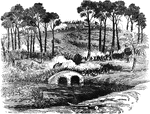
Battle of Antietam
"Battle of Antietam, Md. Burnside's division carrying the bridge over the Antietam Creek and storming…

Fort Thompson
"Bombardment and capture of Fort Thompson, thirteen guns, near New Berne, on the Neuse River, by the…

Pocotaligo Bridge
"The Federal troops under Generals Brannan and Terry driving the Confederates under beauregard across…

Reconnoissance
"Reconnoissance by Colonel Max Weber's Turner rifles in the vicinity of Newmarket Bridge, on the road…
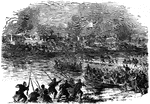
The Forlorn Hope
"'The Forlorn Hope.' Volunteers storming party, consisting of portions of the Seventh Michigan and Nineteenth…

Steamer Alabama
"The Confederate privateer steamer Alabama (290). Captain Raphael Semmes. Our illustration…

Federals Crossing
"Federal Volunteers crossing from Cincinnati to Covington on a bridge of coal boats, constructed for…

Battle of Antietam
"Battle of Antietam, Burnside's Division, left wing- brilliant and decisive bayonet charge of Hawkins's…

Battle of Baker's Creek
"Battle of Baker's Creek, May 16th, 1862- Defeat of the Confederates under Pemberton, by General Grant.…
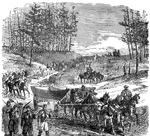
Pontoon Bridge
"The Pontoon bridge 'On The March'- the pontoon wagons on their way from Aquia Creek to the Rappahannock.…
Falmouth
"The town of Falmouth, Va. on the Rappahannock, opposite Fredericksburg. Headquarters of General Burnside…

Wounded Federals
"Towing the wounded Federal soldiers down the bayou on a raft, on the night of January 14th, 1863, after…

Battle of Grand Coteau
"Battle of Grand Coteau, La., November 3rd, furious attack on the Sixtieth Indiana, Colonel Owen. On…

Entering Clinton
"General McPherson entering Clinton, Miss. To facilitate the movements of the Federal armies near Chattanooga…

War in Louisiana
"The war in Louisiana. The army of General Banks crossing Vermilion Bayou, October 10th, 1863. Our artist…

War in Mississippi
"The war in Mississippi. General McPherson's army crossing the Big Black at messenger's Ferry, Thursday,…

War in Louisiana
"The war in Louisiana. General Banks's army, in the advance on Shreveport, crossing Cane River, March…

Sheridan's Great Battle
"The war in Virginia- Sheridan's Great Battle with J. E. B. Stuart at Yellow Tavern, May 11th, 1864-…

Belle Isle
"View of Richmond, Va., from the prison camp at Belle Isle, James River. Belle Island is situated in…

Seventeenth Corps
"Sherman's Seventeenth Corps crossing the south Edisto River, S. C., on Pontoons, at Bennaker's Bridge,…

War in Virginia
"The war in Virginia--railroad bridge over the Rappahannock, at Rappahannock Station."— Frank Leslie,…
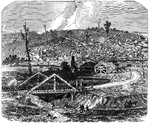
Canton Road
"The war in Mississippi- General McPherson driving the enemy from their position on the Canton Road,…



